Remains of Anglo-Saxon princess who could be the Queen’s earliest known relative discovered by scientists in Kent
Eanswythe, the daughter of King Eadbald, is believed to have founded England’s first nunnery before her life was cut short, likely as a result of bubonic plague
An Anglo-Saxon princess who was one of England’s earliest Christian saints has been identified by scientists in a church in Kent.
Some historical evidence suggests that she may be the present Queen’s earliest known relative whose remains have so far been identified.
Dating from the mid-seventh century AD, the princess was the daughter of King Eadbald (literally “the prosperous one”), the ruler of the Anglo-Saxon kingdom of Kent, who was that micro-country’s monarch from 616 (or 618) to 640.
Parts of the Kentish royal dynasty’s lineage are unclear but some interpretations of their genealogy suggests that he was the present Queen’s 40th great grandfather.
His daughter Eanswythe, whose fragmentary skeleton has just been identified, was a devout Christian who was said to have refused to marry the pagan king of northeast England; and instead decided to become a nun.
The St Eanswythe excavation in pictures
Show all 9
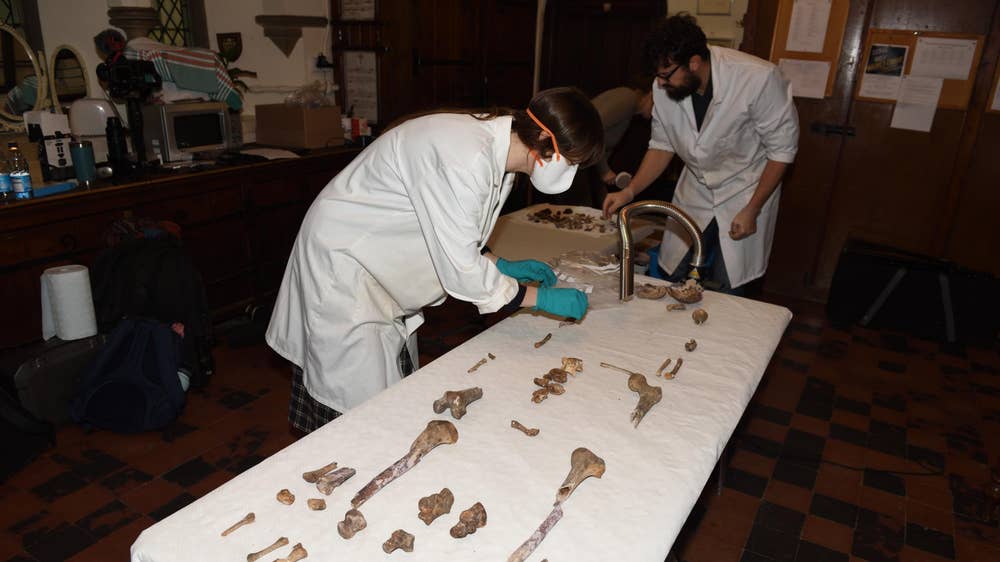
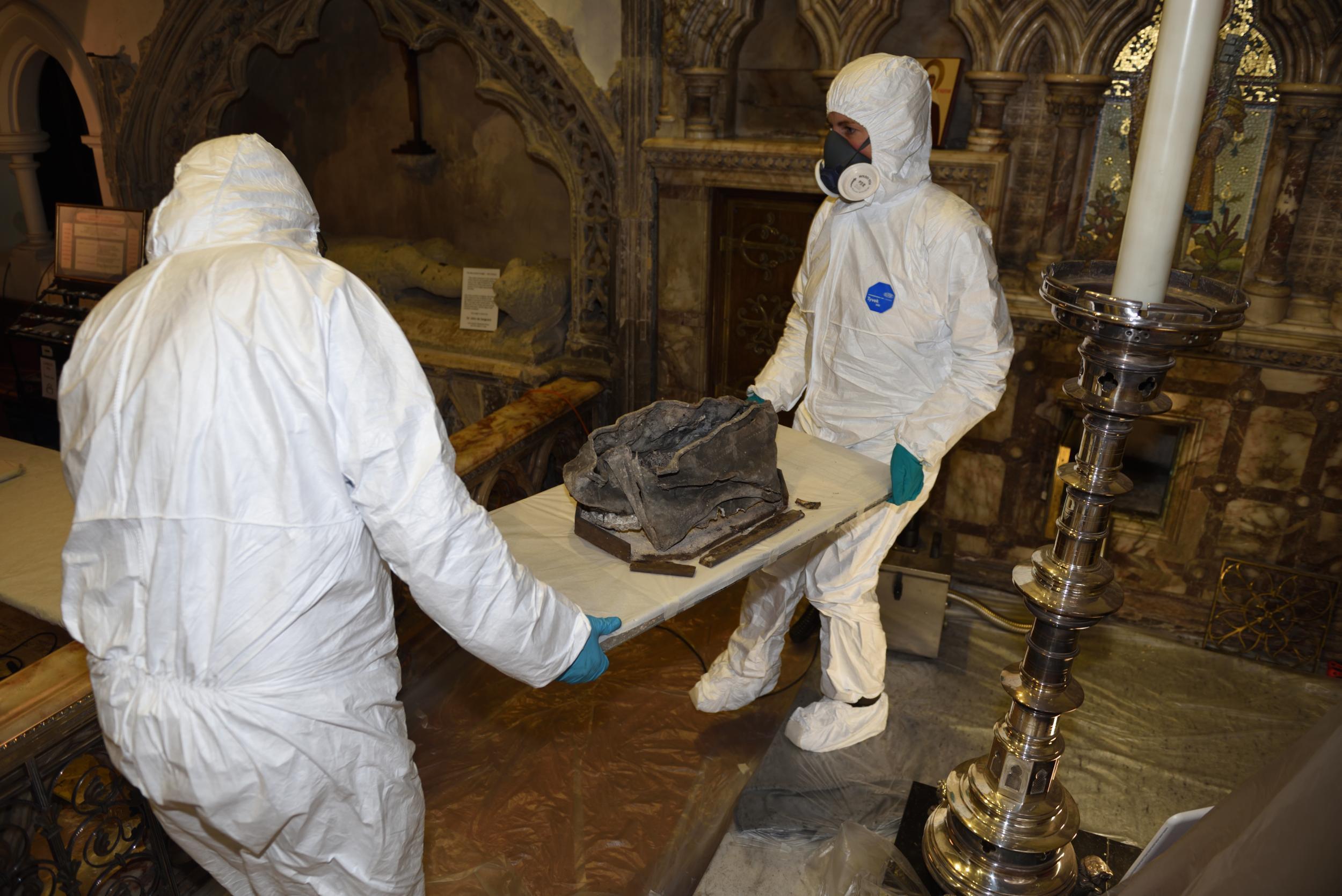
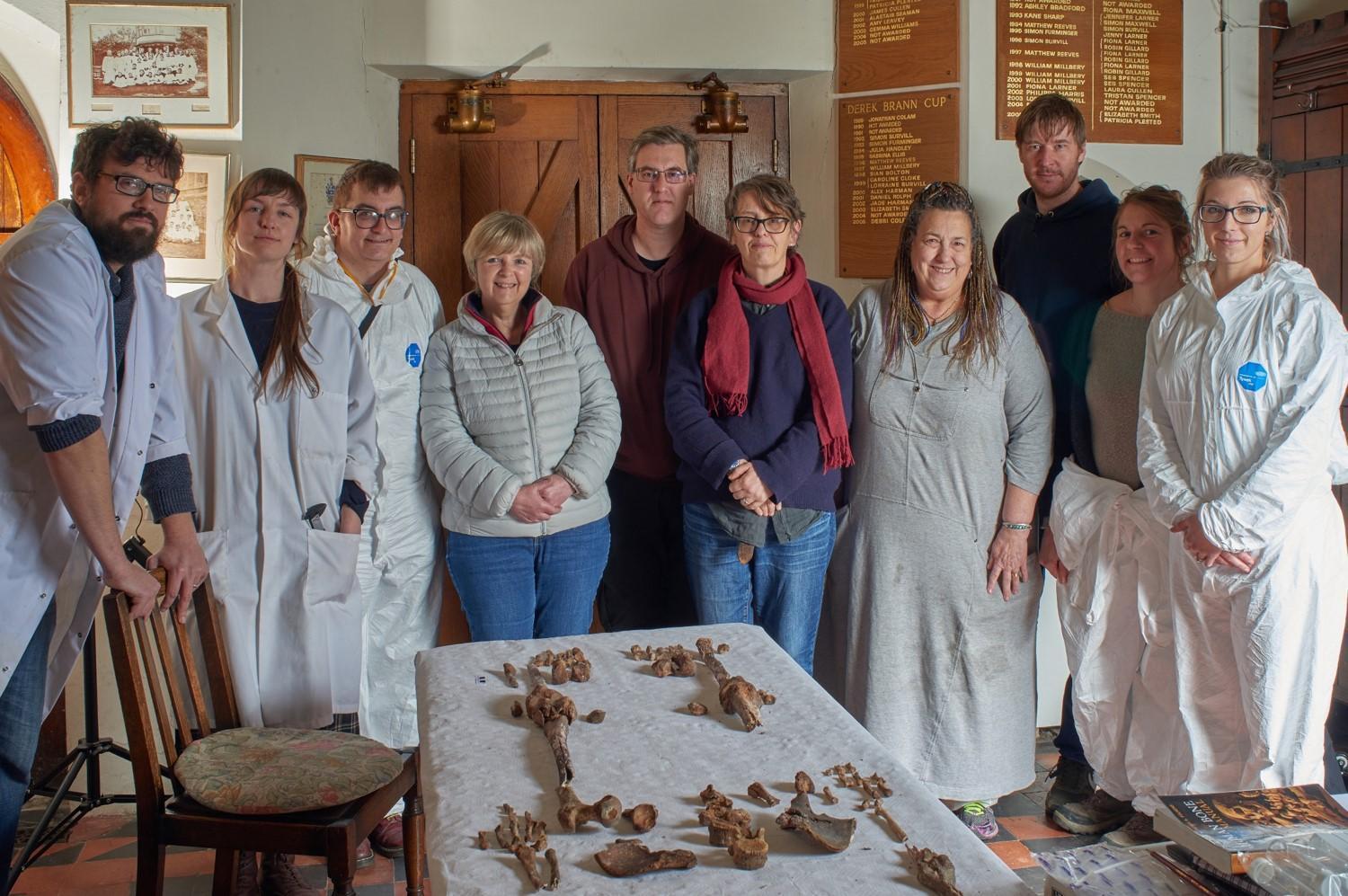
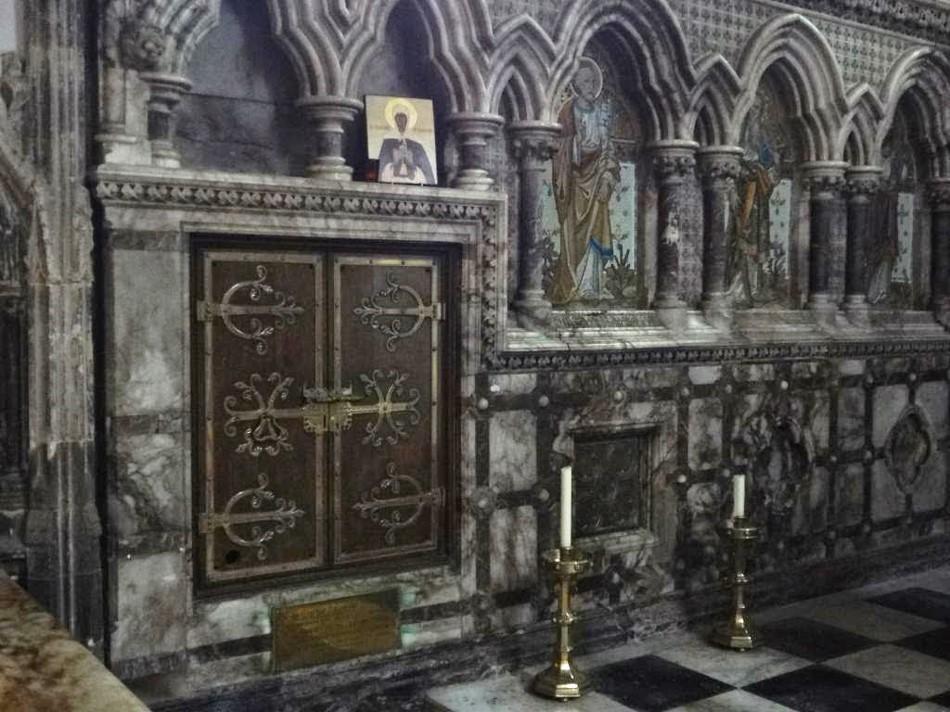
Although only a teenager at the time, she is believed to have founded and became abbess of what may well have been England’s first nunnery – potentially at the request of her brother, Eorcenberht, Eadbald’s successor as king.
She was the granddaughter of Bertha, a Christian queen of Kent who, along with St Augustine, was arguably the key individual responsible for helping to initiate pagan Anglo-Saxon England’s conversion to Christianity.
But tragically, Eanswythe’s life was cut short – possibly by a bubonic plague epidemic – and she died in her late teens or very early 20s.
She was and still is the patron saint of Folkestone and a local history project, aptly called “Finding Eanswythe”, is using the full panoply of modern science to rediscover the long-lost secrets of her life.
A thorough examination of her surviving teeth suggests that she ate relatively refined food. In life, her dentition appears to have been pristine – with virtually no pre-death wear and tear.
Her bones also showed very little sign of injury – apart from a potential stress fracture in one foot bone and two possible damaged finger bones.
Now the “Finding Eanswythe” project, supported by Folkstone Museum, hopes to analyse her DNA and the DNA of any pathogens in her bones to learn more about her royal lineage and to reveal whether or not she died from the plague.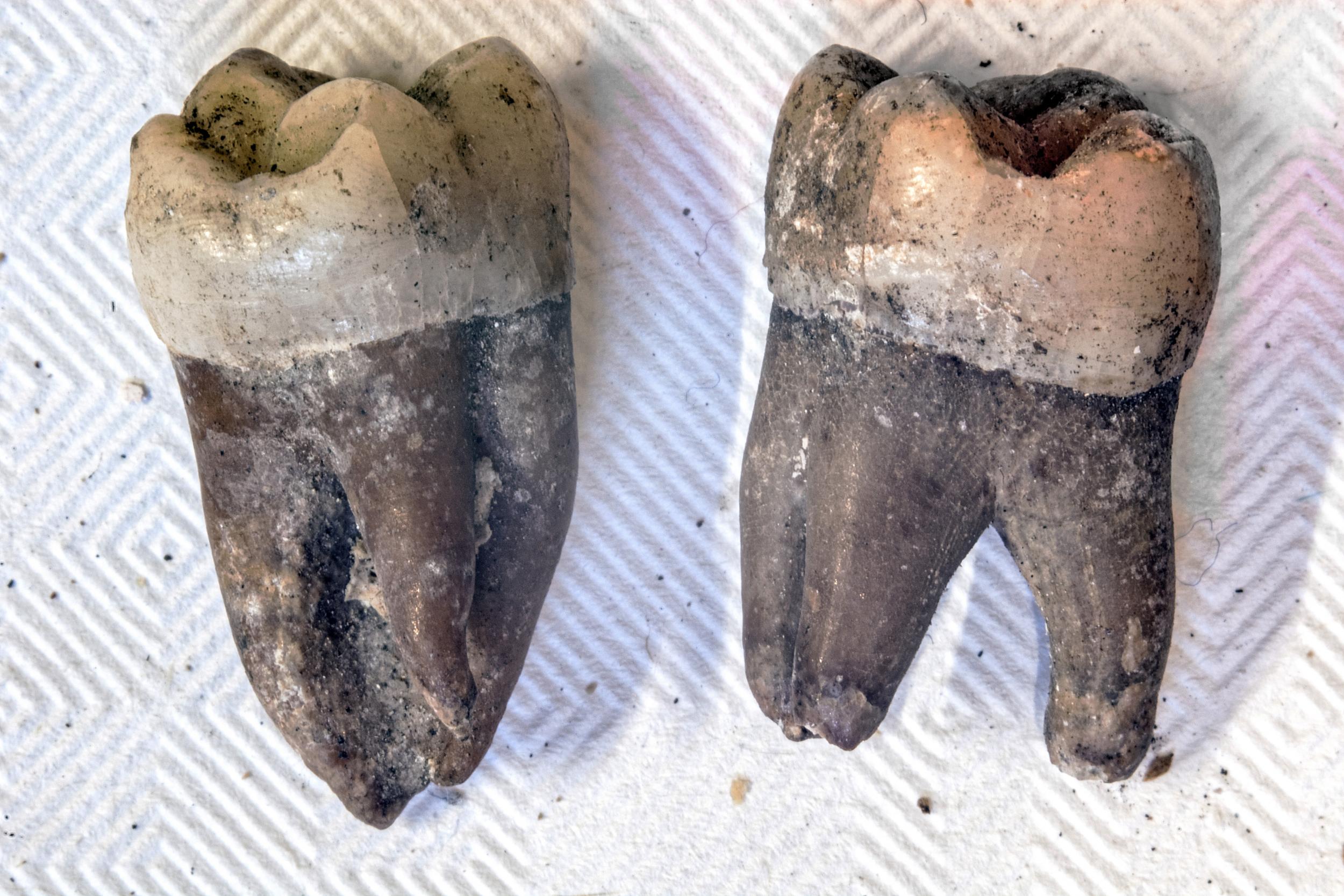
Data from the royal saint’s teeth, above, were crucial to her identification (Kevin Harvey/Folkestone Museum)
Isotopic analysis will also be carried out and may reveal where she grew up and more details about her diet. Although her life was tragically short, her afterlife was rather more dramatic.
After her death, according to mediaeval accounts, she was buried in her own private chapel, overlooking the sea above Folkestone. But as coastal erosion undercut the cliffs, the abbesses who succeeded her increasingly realised that the building would eventually end up crashing into the sea below.
Some time in the eighth century her remains were removed from the stricken chapel and put into a specially built shrine in the nunnery’s main church. By the late 11 century, the nunnery had become a monastery.
However, following the Norman conquest, a castle was built around it – so, in the 12 century, the monks demanded that they be allowed to move to a new, less secular, site.
The princess’s bones were therefore disinterred again and moved, in 1138, a few hundred metres away to a brand new church, a later version of which still stands today as Folkestone’s Parish Church. There she became the centre of a local cult and was believed to be able to help cure disease. Her official saint’s day is 12 September.
But, after the mediaeval period had drawn to a close, Eanswythe’s story took a new and unexpected turn.
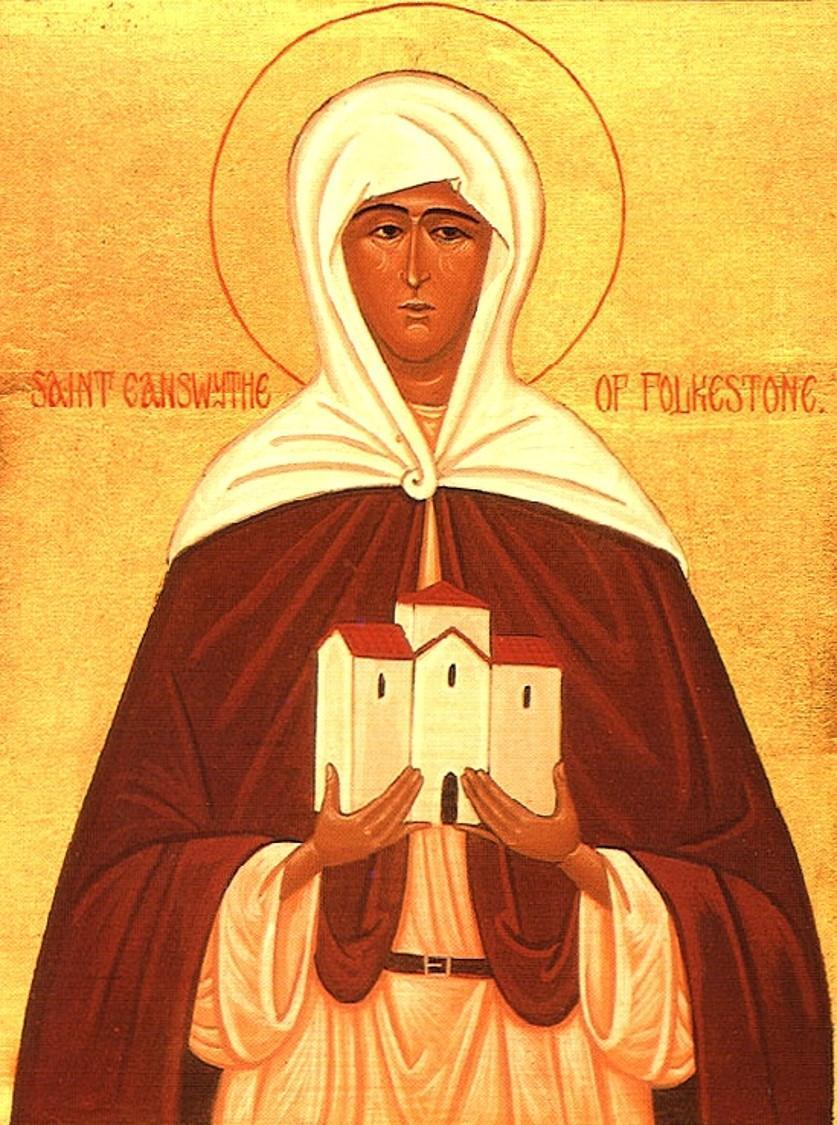
Icon donated by Orthodox pilgrims to St Eanswythe’s
shrine (© Church of St Mary and St Eanswythe, Folkestone)
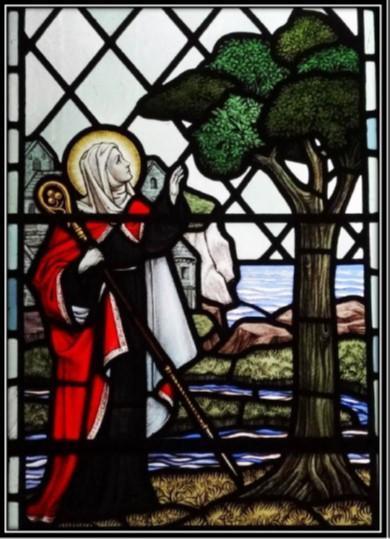
Stained glass window (depicting St Eanswythe) in the Church of St Mary
and St Eanswythe (© Church of St Mary and St Eanswythe, Folkestone)
When Henry VIII broke away from the Roman Catholic Church and established the Church of England, the government became increasingly hostile to the veneration of saints. In 1535, the prior of Folkestone seems to have realised that, unless he took drastic action, government officials would seize and destroy Eanswythe’s bones. So he (or some of his monks) appear to have hurriedly forced the lead box containing them into a secret hole in the church wall and blocked it off.
The prior, or a senior church member, then showed the officials a probably gold or gem-studded reliquary, almost certainly containing just a few parts of the saint’s skull.
That box, with its diminished contents, was subsequently seized by the government and was then acquired by a member of Henry VIII’s household, a Folkestone politician and businessman called Anthony Aucher, who no doubt profited substantially by selling any gems which had adorned the reliquary.
Meanwhile, Eanswythe rested safe and secure in her dark hiding place inside the church’s north wall, just beside the altar.
Gradually her hiding place was forgotten – until, in 1885, workmen engaged in modernising the church stumbled across her remains. There was immediate speculation about the possibility that they could be the bones of St Eanswythe and the discovery was reported in newspapers worldwide.
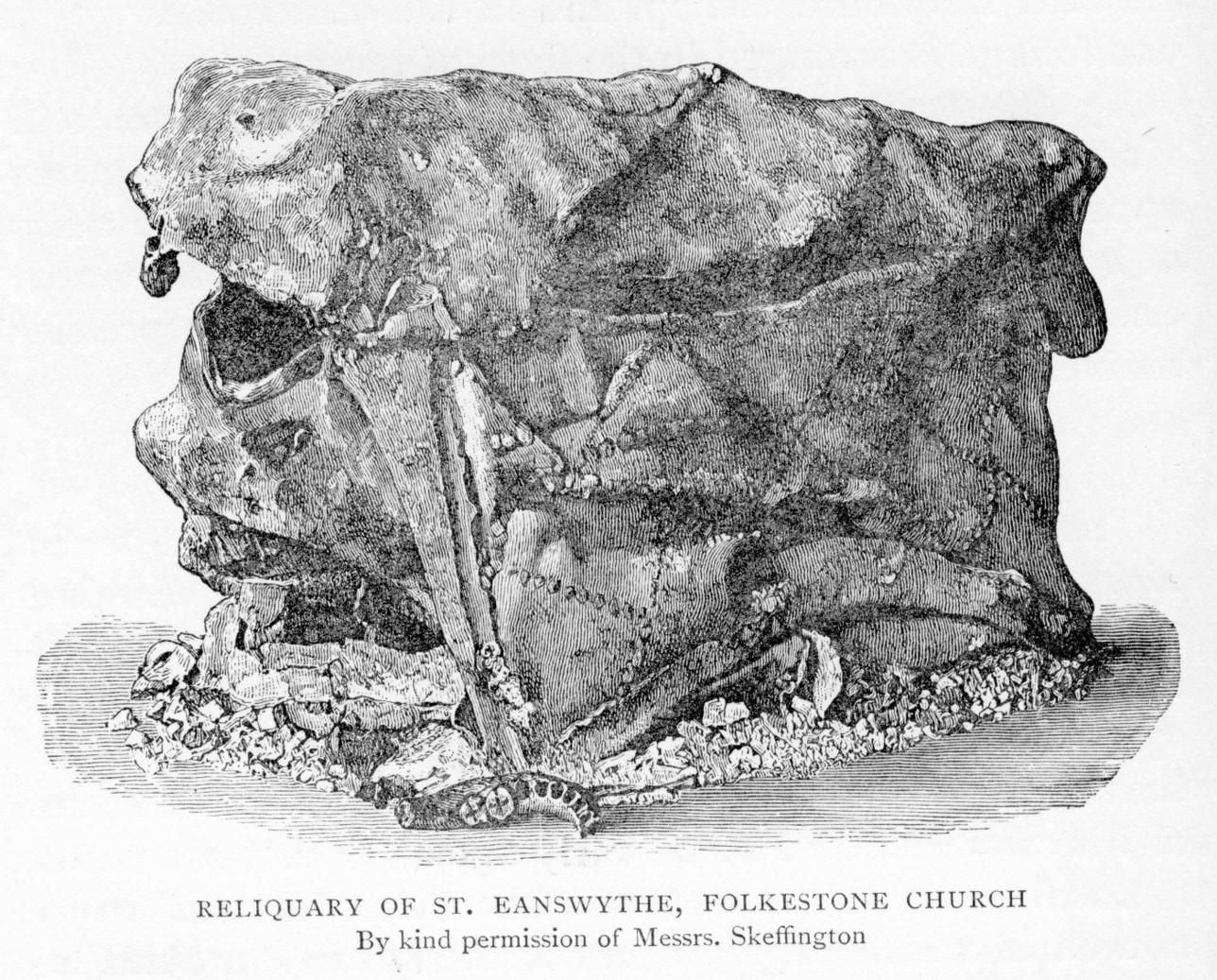
Image of the lead container and bones found by workmen in June 1885 published in Archaeologia Cantiana in 1886 (© Kent Archaeological Society)
But in the 19th century, there was no way of confirming her identity.
So for 132 years, the bones were stashed away in a specially constructed wall niche and once again began to fade from memory, until just three years ago a group of local historians and archaeologists decided to try to solve the mystery.
They did so by asking scientists to examine the bones in order to discover the long-dead individual’s age at death and sex – and by carrying out radiocarbon dating tests to ascertain whether the bones did indeed date from the seventh century.
The answers virtually proved that the fragmentary skeleton was indeed that of St Eanswythe.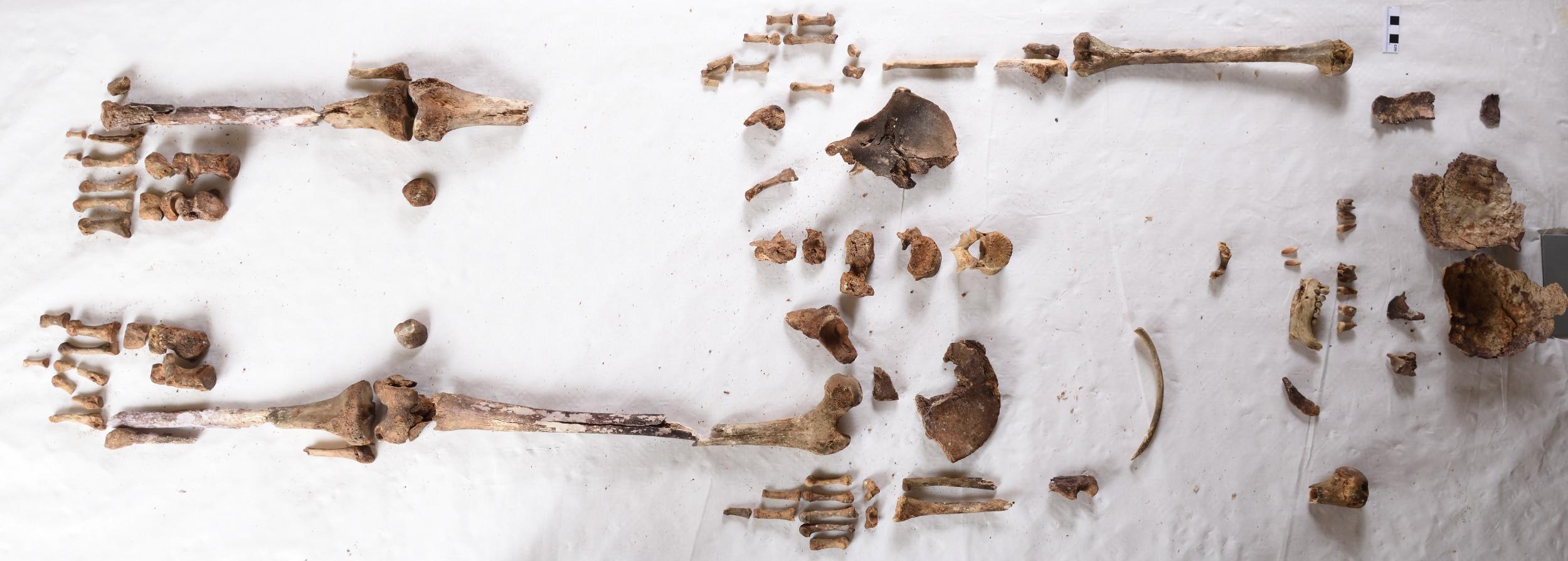
The bones showed very little signs of distress (Mark Hourahane/Folkestone Museum)
The scientists were able to demonstrate that the individual was almost certainly female.
Medieval sources had said that she had died very young – and the scientific examination of her bones and teeth revealed that the individual had been between 17 and 21 years old when she had passed away.
The radiocarbon tests then revealed that she had died in the mid-seventh century – the exact period when Eanswythe‘s life ended.
What’s more, examination of her teeth showed virtually no pre-death scratches on her tooth enamel, a fact that suggests that she had consumed relatively little coarse food.
Throughout the medieval period, a large number of stories attached themselves to her. She was credited with at least five miracles and was venerated by people in the Folkestone area.
She was believed, for instance, to have miraculously made water run uphill (a story probably developed in order to explain an optical illusion which seemed to show a local aqueduct channelling water up a gradient). She was also credited for resurrecting a dead goose that had been stolen and eaten.
Eanswythe was also said to have miraculously lengthened a wooden beam to construct a church by calling on Christ to help when a pagan king and his gods had failed to lengthen it.
And after her death, her ghost was said to have cured a man suffering from leprosy or some other skin disease.
Read more
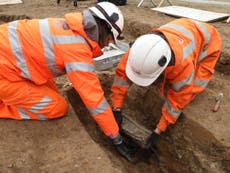
Eanswythe, the daughter of King Eadbald, is believed to have founded England’s first nunnery before her life was cut short, likely as a result of bubonic plague
An Anglo-Saxon princess who was one of England’s earliest Christian saints has been identified by scientists in a church in Kent.
Some historical evidence suggests that she may be the present Queen’s earliest known relative whose remains have so far been identified.
Dating from the mid-seventh century AD, the princess was the daughter of King Eadbald (literally “the prosperous one”), the ruler of the Anglo-Saxon kingdom of Kent, who was that micro-country’s monarch from 616 (or 618) to 640.
Parts of the Kentish royal dynasty’s lineage are unclear but some interpretations of their genealogy suggests that he was the present Queen’s 40th great grandfather.
His daughter Eanswythe, whose fragmentary skeleton has just been identified, was a devout Christian who was said to have refused to marry the pagan king of northeast England; and instead decided to become a nun.
The St Eanswythe excavation in pictures
Show all 9




Although only a teenager at the time, she is believed to have founded and became abbess of what may well have been England’s first nunnery – potentially at the request of her brother, Eorcenberht, Eadbald’s successor as king.
She was the granddaughter of Bertha, a Christian queen of Kent who, along with St Augustine, was arguably the key individual responsible for helping to initiate pagan Anglo-Saxon England’s conversion to Christianity.
But tragically, Eanswythe’s life was cut short – possibly by a bubonic plague epidemic – and she died in her late teens or very early 20s.
She was and still is the patron saint of Folkestone and a local history project, aptly called “Finding Eanswythe”, is using the full panoply of modern science to rediscover the long-lost secrets of her life.
A thorough examination of her surviving teeth suggests that she ate relatively refined food. In life, her dentition appears to have been pristine – with virtually no pre-death wear and tear.
Her bones also showed very little sign of injury – apart from a potential stress fracture in one foot bone and two possible damaged finger bones.
Now the “Finding Eanswythe” project, supported by Folkstone Museum, hopes to analyse her DNA and the DNA of any pathogens in her bones to learn more about her royal lineage and to reveal whether or not she died from the plague.

Data from the royal saint’s teeth, above, were crucial to her identification (Kevin Harvey/Folkestone Museum)
Isotopic analysis will also be carried out and may reveal where she grew up and more details about her diet. Although her life was tragically short, her afterlife was rather more dramatic.
After her death, according to mediaeval accounts, she was buried in her own private chapel, overlooking the sea above Folkestone. But as coastal erosion undercut the cliffs, the abbesses who succeeded her increasingly realised that the building would eventually end up crashing into the sea below.
Some time in the eighth century her remains were removed from the stricken chapel and put into a specially built shrine in the nunnery’s main church. By the late 11 century, the nunnery had become a monastery.
However, following the Norman conquest, a castle was built around it – so, in the 12 century, the monks demanded that they be allowed to move to a new, less secular, site.
The princess’s bones were therefore disinterred again and moved, in 1138, a few hundred metres away to a brand new church, a later version of which still stands today as Folkestone’s Parish Church. There she became the centre of a local cult and was believed to be able to help cure disease. Her official saint’s day is 12 September.
But, after the mediaeval period had drawn to a close, Eanswythe’s story took a new and unexpected turn.
Icon donated by Orthodox pilgrims to St Eanswythe’s
shrine (© Church of St Mary and St Eanswythe, Folkestone)

Stained glass window (depicting St Eanswythe) in the Church of St Mary
and St Eanswythe (© Church of St Mary and St Eanswythe, Folkestone)
When Henry VIII broke away from the Roman Catholic Church and established the Church of England, the government became increasingly hostile to the veneration of saints. In 1535, the prior of Folkestone seems to have realised that, unless he took drastic action, government officials would seize and destroy Eanswythe’s bones. So he (or some of his monks) appear to have hurriedly forced the lead box containing them into a secret hole in the church wall and blocked it off.
The prior, or a senior church member, then showed the officials a probably gold or gem-studded reliquary, almost certainly containing just a few parts of the saint’s skull.
That box, with its diminished contents, was subsequently seized by the government and was then acquired by a member of Henry VIII’s household, a Folkestone politician and businessman called Anthony Aucher, who no doubt profited substantially by selling any gems which had adorned the reliquary.
Meanwhile, Eanswythe rested safe and secure in her dark hiding place inside the church’s north wall, just beside the altar.
Gradually her hiding place was forgotten – until, in 1885, workmen engaged in modernising the church stumbled across her remains. There was immediate speculation about the possibility that they could be the bones of St Eanswythe and the discovery was reported in newspapers worldwide.

Image of the lead container and bones found by workmen in June 1885 published in Archaeologia Cantiana in 1886 (© Kent Archaeological Society)
But in the 19th century, there was no way of confirming her identity.
So for 132 years, the bones were stashed away in a specially constructed wall niche and once again began to fade from memory, until just three years ago a group of local historians and archaeologists decided to try to solve the mystery.
They did so by asking scientists to examine the bones in order to discover the long-dead individual’s age at death and sex – and by carrying out radiocarbon dating tests to ascertain whether the bones did indeed date from the seventh century.
The answers virtually proved that the fragmentary skeleton was indeed that of St Eanswythe.

The bones showed very little signs of distress (Mark Hourahane/Folkestone Museum)
The scientists were able to demonstrate that the individual was almost certainly female.
Medieval sources had said that she had died very young – and the scientific examination of her bones and teeth revealed that the individual had been between 17 and 21 years old when she had passed away.
The radiocarbon tests then revealed that she had died in the mid-seventh century – the exact period when Eanswythe‘s life ended.
What’s more, examination of her teeth showed virtually no pre-death scratches on her tooth enamel, a fact that suggests that she had consumed relatively little coarse food.
Throughout the medieval period, a large number of stories attached themselves to her. She was credited with at least five miracles and was venerated by people in the Folkestone area.
She was believed, for instance, to have miraculously made water run uphill (a story probably developed in order to explain an optical illusion which seemed to show a local aqueduct channelling water up a gradient). She was also credited for resurrecting a dead goose that had been stolen and eaten.
Eanswythe was also said to have miraculously lengthened a wooden beam to construct a church by calling on Christ to help when a pagan king and his gods had failed to lengthen it.
And after her death, her ghost was said to have cured a man suffering from leprosy or some other skin disease.
Read more

Excavations of medieval chapel at site linked to King Arthur
But, beyond those legends, what was her real significance?
In a sense, she symbolises the huge contribution to early English history made by high-status women. Prior to the coming of Christianity, it is not known whether Anglo-Saxon women played any major political roles.
But the coming of Christianity certainly provided one. Princesses played a major part in the conversion of England from paganism to the new faith. When Anglo-Saxon and other Christian princesses married pagan Anglo-Saxon kings, their presence often allowed Christianity to gain the upper hand and flourish.
What’s more, those royal daughters who did not marry kings and princes were established by their royal fathers or brothers as abbesses of a new type of institution – nunneries, which in turn, alongside the monasteries, began to wield substantial social and cultural influence. Many of the new abbesses (like Eanswythe) became popular saints and were revered for centuries.
St Eanswythe died some 1,360 years ago but her newly rediscovered life and times are about to captivate a new audience.
“Our identification of St Eanswythe’s skeletal remains open up the possibility of using DNA to investigate the ancestry of the Kentish and Frankish royal dynasties,” said the senior archaeologist involved in the project, Dr Andrew Richardson of the Canterbury Archaeological Trust.
“St Eanswythe was a local heroine of great relevance to local people. In mediaeval times, they saw her as their protector from disease and suffering. Researching her today will bring the people of Folkestone nearer to that history,” said the head of the Finding Eanswythe project, Dr Lesley Hardy, a historian at Canterbury Christ Church University.
The project is being largely financed by the National Lottery Heritage Fund.
But, beyond those legends, what was her real significance?
In a sense, she symbolises the huge contribution to early English history made by high-status women. Prior to the coming of Christianity, it is not known whether Anglo-Saxon women played any major political roles.
But the coming of Christianity certainly provided one. Princesses played a major part in the conversion of England from paganism to the new faith. When Anglo-Saxon and other Christian princesses married pagan Anglo-Saxon kings, their presence often allowed Christianity to gain the upper hand and flourish.
What’s more, those royal daughters who did not marry kings and princes were established by their royal fathers or brothers as abbesses of a new type of institution – nunneries, which in turn, alongside the monasteries, began to wield substantial social and cultural influence. Many of the new abbesses (like Eanswythe) became popular saints and were revered for centuries.
St Eanswythe died some 1,360 years ago but her newly rediscovered life and times are about to captivate a new audience.
“Our identification of St Eanswythe’s skeletal remains open up the possibility of using DNA to investigate the ancestry of the Kentish and Frankish royal dynasties,” said the senior archaeologist involved in the project, Dr Andrew Richardson of the Canterbury Archaeological Trust.
“St Eanswythe was a local heroine of great relevance to local people. In mediaeval times, they saw her as their protector from disease and suffering. Researching her today will bring the people of Folkestone nearer to that history,” said the head of the Finding Eanswythe project, Dr Lesley Hardy, a historian at Canterbury Christ Church University.
The project is being largely financed by the National Lottery Heritage Fund.

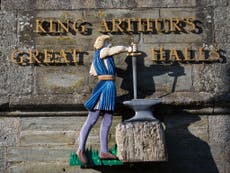
No comments:
Post a Comment